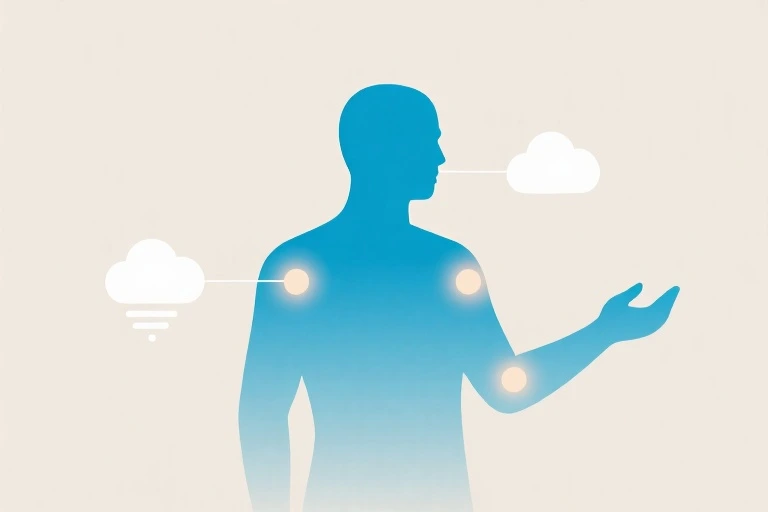You booked the flights months in advance, packed your favorite beach read, and even set that bold ‘out of office’ reply. The first few days felt glorious – toes in the sand, no Slack notifications, that novel actually getting read past chapter three. But as you drag your suitcase back home, something feels off. The fatigue that vacation was supposed to fix now sits heavier on your shoulders, like you’ve brought back extra luggage filled with invisible weights.
This isn’t how it’s supposed to work. Society promises that two weeks in Hawaii should reset your batteries, yet here you are staring at your work calendar with the same bone-deep exhaustion, maybe even worse than before you left. That creeping suspicion you’ve been ignoring? It’s time to name it: what you’re experiencing isn’t normal tiredness. It’s the hallmark of burnout – your body’s final warning system before complete shutdown.
The myth we’ve been sold about vacations being cure-alls for chronic stress is as flawed as expecting a single salad to undo years of fast food. Real recovery doesn’t happen in the seven days between your outbound and return flights. Burnout develops through hundreds of unnoticed mornings when you answered emails before brushing your teeth, through quarters where ‘temporary’ crunch time became permanent operating procedure, through years of mistaking adrenaline surges for sustainable energy.
Our cultural script around rest is fundamentally broken. We’ve created workplaces where ‘I’m so busy’ functions as a status symbol, where uninterrupted lunch breaks feel illicit, where checking vacation emails gets praised as dedication rather than recognized as self-sabotage. This hustle culture doesn’t just discourage proper rest – it actively pathologizes it. Taking a proper lunch hour becomes ‘slacking,’ setting boundaries gets labeled ‘not being a team player,’ and real disconnection gets rebranded as ‘quiet quitting.’
Here’s what no one tells you about burnout recovery: time off alone won’t fix it because burnout isn’t about hours logged – it’s about nervous system damage. That foggy thinking? That’s your prefrontal cortex running on empty. The Sunday night dread? Your amygdala stuck in permanent threat detection. The emotional numbness? Your dopamine receptors worn down like overused piano keys. These aren’t issues a piña colada can solve.
Before we can talk solutions (and yes, there are real ones coming in Part 2), we need to acknowledge the uncomfortable truth: your vacation failed because it was never designed to succeed. The real work begins when we stop expecting tropical getaways to compensate for daily grind and start rebuilding our relationship with rest from the ground up. Your body isn’t broken for still feeling exhausted – it’s finally being heard.
Tomorrow’s small step: Before closing this tab, take thirty seconds to notice one physical sensation (the weight of your feet on the floor, the temperature of air in your nostrils). This isn’t mindfulness fluff – it’s the first neural handshake with a nervous system that’s been waiting years for you to check in.
The Vacation Paradox: Why You Feel Worse After Time Off
You booked the flights months in advance, packed your favorite beach read, and even set that cheerful ‘out of office’ reply. The first three days felt glorious – no Slack pings, no spreadsheet-induced headaches, just the rhythmic crash of waves and the smell of sunscreen. But by day five, a familiar tightness returned to your shoulders. That unfinished project started creeping into your sunset thoughts. Now you’re back at your desk, blinking at your screen with a fatigue deeper than before you left.
This isn’t vacation failure – it’s what researchers call Post-Vacation Burnout Paradox. Like drinking seawater when thirsty, our attempts at quick relief often worsen the dehydration. The key lies in understanding two distinct types of exhaustion:
Temporary Fatigue (what we think we have)
- Improves with 2-3 days of rest
- Body-focused (sore muscles, sleepiness)
- Motivation returns quickly
Burnout (what we actually have)
- Persists despite weeks off
- Brain-focused (mental fog, emotional numbness)
- Chronic motivation deficit
Your nervous system isn’t designed for the modern work rhythm of 50 weeks of high-alert stress followed by 2 weeks of forced relaxation. Neuroscientists compare it to revving a car engine nonstop for months, then expecting a single oil change to undo all the wear. The damage shows up in measurable ways: shrunken hippocampal volume from cortisol overload, prefrontal cortex activity patterns resembling PTSD patients.
We’ve been conditioned to view this persistent exhaustion as personal failing. ‘Maybe if I took better vacations…’ you think while scrolling Instagram photos of coworkers hiking Machu Picchu. But the real culprit is what psychiatrist Anna Katharina Schaffner calls ‘the productivity cult’ – where we wear sleep deprivation like a badge of honor and confuse constant availability with professionalism.
Notice your own language this week. How often do you apologize for ‘just now’ responding to emails sent 37 minutes ago? When colleagues ask about your time off, do you emphasize how ‘unplugged’ you were as if that’s remarkable? These aren’t personal quirks – they’re symptoms of a system that pathologizes rest.
The path forward isn’t longer vacations (though take them anyway). It’s rebuilding what Stanford researcher Emma Seppälä terms ‘rest infrastructure’ – daily micro-practices that prevent the burnout buildup. But first, we need to properly diagnose the damage. Like physical therapy after an injury, recovery begins with honest assessment of what’s truly weakened.
Your body’s been sending invoices for all those deferred rest payments. The headache that lingers past morning coffee. The unusual clumsiness – spilled drinks, stubbed toes. That strange inability to choose what to watch on Netflix. These aren’t random glitches; they’re your personal burnout indicators flashing yellow. Tomorrow we’ll explore customized recovery plans, but today, try this:
Set a phone timer for 90 minutes. When it rings, step away from all screens for exactly 5 minutes. Don’t ‘do’ anything productive – no quick closet organizing or ‘useful’ podcasts. Just stare at a tree or sip tea while feeling your feet on the floor. It won’t solve everything, but it’s the first deposit in your new rest savings account.
The Hidden Cost of Hustle Culture
We’ve all been there – returning from a supposedly relaxing vacation only to feel more drained than before. That beach read and piña colada should have worked their magic, yet here you are, dragging yourself back to work with the same heavy exhaustion. This paradox isn’t about failed vacations; it’s about living in a society that worships at the altar of productivity while demonizing rest.
The Three Commandments of Productivity Worship
- Busyness as Status Symbol
Our culture has turned ‘I’m so busy’ into a badge of honor. Like medieval knights displaying their scars, we compete to show off our overflowing calendars and sleepless nights. The underlying message? Your worth equals your output. But when researchers at Stanford studied workplace productivity, they found performance sharply declines after 50 hours of weekly work. That trophy you’re polishing might actually be your tombstone. - Rest as Moral Failure
Notice how ‘lazy’ has become the ultimate insult in professional circles? We’ve pathologized downtime until even lunch breaks feel illicit. A global survey by Project Time Off revealed 52% of employees had unused vacation days last year – not because they couldn’t afford trips, but because taking time off felt irresponsible. This mindset creates what psychologists call ‘leisure guilt,’ where relaxation triggers anxiety instead of renewal. - Availability as Professional Virtue
The 3 AM email response has become the new gold standard of dedication. But when French labor laws established the ‘right to disconnect’ in 2017, companies saw decreased burnout rates without productivity loss. Our always-on mentality isn’t making us better workers – it’s making us broken humans.
When Cultures Collide: Global Perspectives on Rest
Compare Silicon Valley’s ‘sleep is for the weak’ mentality with:
- Spain’s siesta tradition: Businesses close midday for rest, yet Spain maintains comparable GDP to non-siesta nations
- Sweden’s 6-hour workday trials: Improved productivity metrics across multiple industries
- Japan’s inemuri (‘sleeping while present’): Culturally accepted workplace napping seen as dedication, not laziness
Neuroscience confirms these cultures might be onto something. The brain’s default mode network – responsible for creativity and problem-solving – activates primarily during rest states. By glorifying constant activity, we’re literally blocking our best thinking.
The Body Keeps the Score
Your exhaustion isn’t imagination or weakness. Chronic stress triggers measurable changes:
- Cortisol dysregulation: Normally peaking in morning, stress hormones start flatlining or spiking erratically
- Prefrontal cortex shrinkage: MRI scans show decision-making areas physically deteriorate under prolonged stress
- Telomere shortening: Those protective DNA caps aging your cells faster than time alone would
This isn’t about working less – it’s about working smarter. Like elite athletes who prioritize recovery as seriously as training, sustainable performance requires honoring our biological needs. The next time you feel guilty for taking a break, remember: even your smartphone gets a charger.
Tomorrow we’ll explore how to spot your personal burnout patterns – the first step toward designing a recovery plan that actually works.
When Your Body Starts Whispering (Then Screaming)
That dull headache that won’t quit. The third time this week you’ve poured orange juice into your coffee mug. That inexplicable moment in the shower when you forgot whether you’d already shampooed. These aren’t just quirky personality traits – they’re your body’s way of sending smoke signals before it starts setting off fireworks.
The Five-Stage Burnout Breakdown
Your stress response system operates like a brilliant but temperamental orchestra conductor. At first, it handles extra workload with grace (Stage 1: The Eager Intern – “I’ve got this!”). Then comes the overcompensation phase (Stage 2: The Overcaffeinated Manager – making cortisol instead of sleep). By Stage 3 (The Exhausted CEO), your adrenal glands start sending resignation letters. The scary part? Most of us don’t notice until we hit Stage 4 (The Empty Office) where even basic decisions feel impossible.
Neuroscience reveals chronic stress physically remodels your brain like a clumsy contractor. The hippocampus (your memory center) shrinks while the amygdala (your panic button) grows. It’s like your mental map getting smaller while the “DANGER!” signs multiply. MRI scans show burnout sufferers have literal gaps in prefrontal cortex activity – the equivalent of your brain’s executive suite losing power during a critical meeting.
Your Personal Burnout Fingerprint
We experience this breakdown differently. Some develop “buzz fatigue” – that wired-but-tired feeling like your nervous system drank ten espressos while your body drags through molasses. Others experience emotional calluses, responding to colleagues with the warmth of a parking meter. My personal warning sign? When I started feeling disproportionately angry at inanimate objects (yes, the printer deserved it, but screaming at a stapler isn’t normal).
These symptoms form patterns as unique as fingerprints. Maybe you’re the type who can power through deadlines but crashes spectacularly afterward. Or perhaps you’ve become frighteningly efficient at work while your personal life resembles a abandoned hobby store. Recognizing your specific burnout signature is step one toward rewriting it.
The Myth of the Resilient Machine
We’ve been sold a dangerous lie that humans should function like smartphones – perpetually rechargeable with minimal downtime. But your biology didn’t get the memo. Unlike devices, our recovery doesn’t follow linear charging curves. It’s more like rehabilitating an ecosystem after drought – some parts bounce back quickly while others need seasons to regenerate.
That moment when you “just don’t care anymore” isn’t moral failure – it’s your anterior cingulate cortex (the brain’s conflict monitor) going on strike. The fumbling with words? That’s your dorsolateral prefrontal cortex rationing mental energy like a blackout-era housewife. These aren’t character flaws but physiological events with timestamps and chemical signatures.
Tomorrow we’ll map out recovery routes, but today’s assignment is simple: Start noticing your body’s quiet reports before they become emergency broadcasts. That tension in your shoulders during Zoom calls? The way you keep misplacing your phone? These aren’t random annoyances – they’re the earliest whispers of a system approaching its limits. The good news? Unlike that printer you yelled at yesterday, your body actually wants to work with you – if you’ll listen.
The Roadmap to Recovery
That moment when you realize your carefully planned vacation didn’t actually recharge you? It’s like pouring a glass of water into a bucket with holes. The problem isn’t the water – it’s the bucket. What you’re experiencing isn’t just failed rest, it’s a structural issue with how your entire system processes stress and recovery.
The Two-Track Repair System
True burnout recovery operates on parallel tracks:
- Cognitive Restoration
- Think of your mind as an overtaxed computer running too many background processes. Chronic stress leaves your prefrontal cortex – the CEO of your brain – constantly scanning for threats. We’ll explore specific techniques for ‘closing tabs’ you didn’t even realize were open.
- Physiological Reset
- Your body keeps score. Elevated cortisol levels from prolonged stress don’t magically normalize during a beach week. The autonomic nervous system gets stuck in fight-or-flight mode like a car idling at 90mph. We’ll examine research-backed methods to manually shift gears.
What most people miss is how these tracks intersect. That afternoon slump isn’t just tiredness – it’s your HPA axis (the body’s stress response system) sending distress flares. The mental fog isn’t lack of focus – it’s your brain conserving energy by temporarily downgrading executive functions.
Your Burnout Fingerprint
Not all burnout manifests the same way. Take this quick mental inventory:
- The Overwhelmed Type: Constantly playing catch-up, feels like drowning in shallow water
- The Disengaged Type: Going through motions with emotional detachment
- The Ineffective Type: Working harder but accomplishing less, like running on a treadmill
(We’ll dive deeper into customized solutions for each type in Part 3)
The First Step Forward
Recovery begins with recognizing you can’t outsmart biology. That ‘just push through’ mentality works until it doesn’t – like ignoring check engine lights until the car breaks down. Tomorrow we’ll explore:
- The 4-phase repair sequence validated by neuroscience
- How to create ‘micro-rest’ opportunities even during busy days
- Why traditional time management fails burned-out brains
For now, try this immediate relief technique: Set a timer for 90 seconds. Breathe in through your nose for 4 counts, hold for 7, exhale through pursed lips for 8. This simple exercise activates your parasympathetic nervous system – the biological ‘brake pedal’ your body forgot how to use.
Remember: Healing isn’t about adding more to your plate. It’s about finally taking things off.
Closing Thoughts: Redefining Rest for True Recovery
That moment when you return from vacation feeling more drained than when you left isn’t some personal failing—it’s your body sending an overdue invoice for all the rest you’ve been borrowing against. We’ve spent years treating our nervous systems like unlimited credit cards, and now the compound interest of chronic stress has come due.
The cultural script tells us rest is what happens between bursts of productivity. But real recovery doesn’t work like commercial breaks in your workday. Your brain isn’t a television you can mute during ads. That persistent fatigue? It’s not your battery running low—it’s your entire operating system begging for an upgrade.
Cognitive reset: Rest isn’t your system shutting down—it’s your patterns rebooting. When you approach recovery as merely the absence of work rather than the presence of restoration, you’re trying to heal a broken leg by not standing on it rather than getting the cast and physical therapy needed for proper healing.
Your 5-Minute Sensory Reset (Start Now)
- Ground your feet: Feel the exact points where your soles meet the floor—the left pinky toe, the right heel, the arch you never notice until it aches.
- Temperature check: Notice where your body holds warmth (those tense shoulders?) and where feels cool (tingling fingertips?). No judgment, just observation.
- Sound inventory: Identify the farthest sound you can detect, then the quietest one nearby. That hum you’ve been tuning out? Let it become part of your awareness.
- Breath rhythm: Don’t alter it yet—just track whether your exhales have been shorter than your inhales (a telltale stress signature).
- Peripheral vision: Soften your gaze to take in the outer edges of what you can see without turning your head—the antidote to screen-tunnel vision.
This isn’t another productivity hack to squeeze between meetings. It’s the neurological equivalent of shaking a snow globe—letting all the frantic thoughts settle so you can see clearly again. Tomorrow we’ll explore how to redesign your daily routine around these micro-resets rather than trying to compensate with annual escapes. Because the solution to burnout isn’t better vacations—it’s building a life that doesn’t require recovery from itself.





